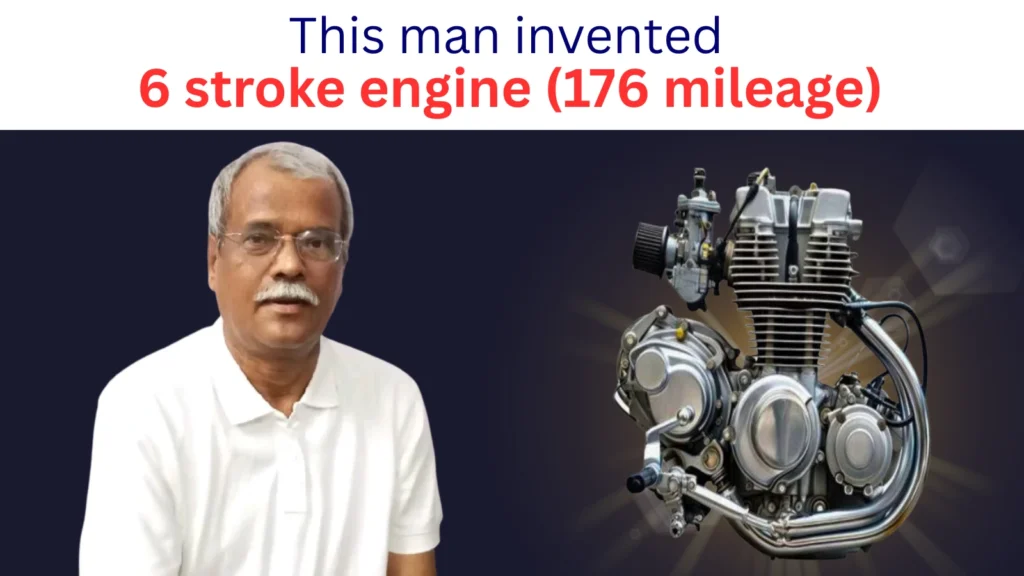Introduction
In today’s world, rising fuel costs and environmental pollution have become major concerns for both consumers and industries. Conventional internal combustion engines, which power most vehicles globally, face limitations in fuel efficiency and contribute significantly to carbon emissions.
The need for innovative solutions to improve fuel efficiency while reducing environmental impact has never been greater. Enter Shailendra Singh Gaur, an Indian innovator whose development of a 6 stroke engine has the potential to revolutionize the automotive industry. This groundbreaking invention not only promises exceptional fuel efficiency but also sets a new benchmark in sustainable mobility.
Following are quick links for this article
ALSO READ: Is the Honda SP 125 a Good Option to Buy in 2025? Complete Buyer’s Guide
About the Innovator: Shailendra Singh Gaur
Shailendra Singh Gaur is an alumnus of Allahabad University, where he completed a B.Sc. degree in Physics, Chemistry, and Mathematics. Born in Kanpur and currently residing in Jhunsi, Prayagraj, he displayed an extraordinary passion for innovation from an early age. In 2007, he made the bold decision to decline a job offer from Tata Motors to pursue independent research in automotive technology.

Over the next 18 years, Gaur dedicated himself to developing a more efficient engine. His home became a laboratory, and he invested his personal resources by selling his land, house, and shop to fund his research. His unwavering determination and commitment to creating a high-efficiency, environmentally friendly engine have made him a remarkable figure in the field of mechanical engineering and automotive innovation.
The Problem with Conventional Engines
To appreciate the significance of the 6 stroke engine, it is important to understand the limitations of traditional 4-stroke engines. Conventional engines operate through four cycles:
- Intake stroke – the fuel-air mixture enters the cylinder.
- Compression stroke – the mixture is compressed for combustion.
- Power stroke – the combustion of fuel pushes the piston, producing mechanical energy.
- Exhaust stroke – burnt gases are expelled from the cylinder.
Despite their widespread use, 4-stroke engines only utilize about 30% of the fuel’s energy, leading to high fuel consumption. Additionally, these engines emit pollutants such as carbon monoxide, carbon dioxide, and unburnt hydrocarbons, contributing to environmental damage and health hazards. While hybrid and electric vehicles address some of these issues, their high costs and infrastructure requirements limit widespread adoption, especially in developing countries.
The Concept of the 6 Stroke Engine
Shailendra Singh Gaur’s 6-stroke engine builds upon the 4-stroke cycle by adding two additional strokes to maximize energy extraction and reduce emissions. These extra strokes include:
- Second power stroke (extra expansion) – residual heat from combustion is utilized to push the piston again, extracting more energy from the same fuel.
- Cooling/expelling stroke – a small amount of water or another medium is injected into the cylinder to cool it and expel remaining exhaust gases efficiently, minimizing pollution.
Additionally, the thrust angle of the piston in Gaur’s design is increased from 25° (in conventional engines) to 60°, which improves mechanical efficiency. Enhanced fuel atomization ensures that the combustion process is more complete, further improving fuel economy and reducing harmful emissions.
How Shailendra Singh Gaur’s 6 Stroke Engine Works
The 6-stroke engine operates in a sequence that optimizes energy utilization:
- Intake Stroke – The air-fuel mixture enters the cylinder.
- Compression Stroke – The mixture is compressed, increasing its potential energy.
- First Power Stroke – Combustion pushes the piston, generating mechanical energy.
- Exhaust Stroke – Partially burnt gases are expelled.
- Second Power Stroke (Extra Expansion) – Residual heat is harnessed to push the piston again, improving thermal efficiency.
- Cooling/Expelling Stroke – Water or a similar medium is injected to cool the cylinder and remove remaining exhaust gases, reducing emissions.
This cycle enables the engine to utilize up to 70% of the fuel’s energy, compared to 30% in conventional 4-stroke engines, dramatically increasing fuel efficiency.
Testing and Performance
Shailendra Singh Gaur tested his 6-stroke engine prototype on a 2017-model 100cc TVS motorcycle. The results were astonishing:
- The motorcycle ran for 35 minutes on just 50 milliliters of petrol.
- This translates to a fuel efficiency of 176 km per liter, with potential to reach 200 km per liter with further refinement.
- For comparison, conventional 100cc motorcycles typically achieve 60–75 km per liter.
Such extraordinary results demonstrate the engine’s potential to transform the automotive industry by drastically reducing fuel consumption while maintaining high performance.
Technical Advantages of the 6 Stroke Engine
The 6 stroke engine offers several advantages over conventional engines:
- Exceptional Fuel Efficiency: Achieves nearly three times the mileage of standard engines.
- Reduced Emissions: The cooling/expelling stroke minimizes carbon monoxide, hydrocarbons, and nitrogen oxides.
- Improved Thermal Management: Engine operates at lower temperatures, reducing wear and prolonging lifespan.
- Versatility: Can be adapted for motorcycles, cars, buses, trucks, and even ships.
- Cost-Effective: Reduces fuel expenses and lowers environmental costs.
Challenges and Limitations
While the 6-stroke engine shows great promise, it faces some challenges:
- The technology is currently in the prototype stage and requires further refinement for mass production.
- High initial manufacturing and research costs may hinder widespread adoption.
- Automotive industry adoption may take time due to existing infrastructure and market resistance.
- Additional investment and government support are necessary to bring the engine to commercial use.
Recognition and Patents
Shailendra Singh Gaur has received two patents from the Government of India for his innovative 6-stroke engine, with additional patents pending. His work has garnered attention from media outlets and automotive experts. The recognition not only validates his innovation but also positions him as a visionary in sustainable automotive technology.
Applications and Future Prospects
The potential applications of the 6 stroke engine are vast:
- Automobiles: Motorcycles, scooters, and cars can achieve higher mileage and lower emissions.
- Commercial Vehicles: Buses, trucks, and delivery vehicles can operate more cost-effectively.
- Maritime Industry: Ships and ferries can benefit from lower fuel consumption and reduced environmental impact.
- Energy and Sustainability: The engine can contribute to energy security, reduce dependency on fossil fuels, and promote cleaner transportation.
With proper investment and collaboration with automotive companies, the 6 stroke engine could become a standard in the industry, offering both economic and environmental benefits.
Comparison with Other Fuel-Efficient Technologies
When compared to hybrid, electric, and hydrogen engines, the 6-stroke engine offers:
- Lower Cost: Less expensive than fully electric vehicles or hydrogen fuel systems.
- High Practicality: Compatible with existing infrastructure, fuel stations, and manufacturing processes.
- Environmental Benefits: Comparable emissions reductions without the need for rare materials or extensive charging networks.
This makes Shailendra Singh Gaur’s 6 stroke engine a practical and sustainable alternative for both urban and rural settings, especially in developing countries.
Lessons from Gaur’s Innovation Journey
Shailendra Singh Gaur’s journey teaches valuable lessons:
- Dedication and Sacrifice: Personal commitment and resource investment are crucial for innovation.
- Independent Thinking: Not all breakthroughs require corporate backing; individual initiative can lead to major technological advancements.
- Persistence: Overcoming obstacles and working relentlessly toward a goal can yield transformative results.
- Inspiration: Gaur’s story motivates young engineers and students to pursue research and innovation, regardless of resource constraints.
Conclusion
The 6 stroke engine developed by Shailendra Singh Gaur represents a revolutionary step in automotive engineering. By significantly improving fuel efficiency, reducing emissions, and utilizing innovative engineering principles, it offers a sustainable alternative to conventional engines. With further research, investment, and industry collaboration, this engine has the potential to reshape the future of mobility—not just in India, but globally.
For enthusiasts, investors, and innovators, Gaur’s 6 stroke engine is not only a testament to ingenuity but also a symbol of hope for a cleaner, more sustainable future.
